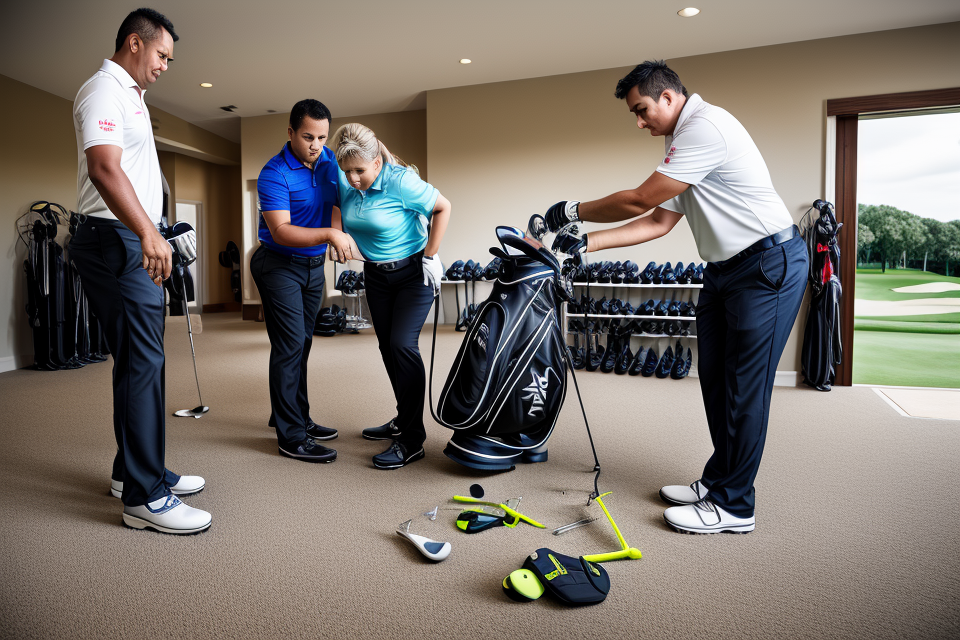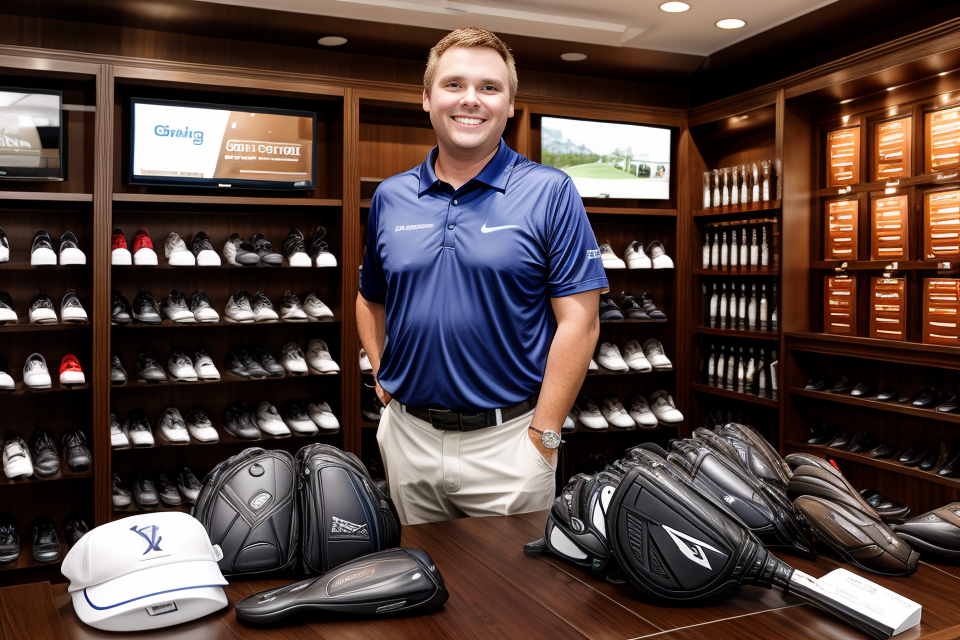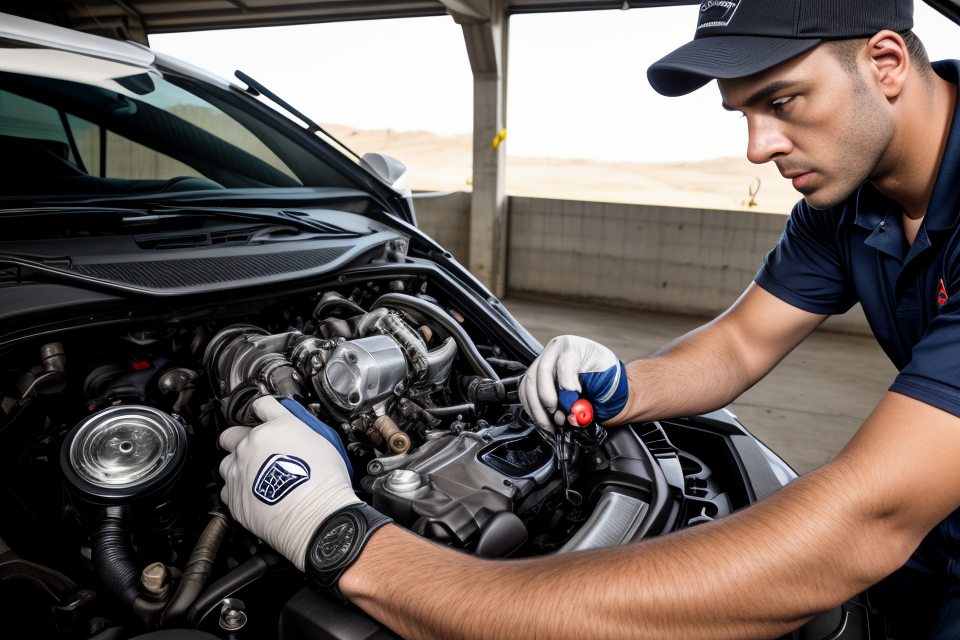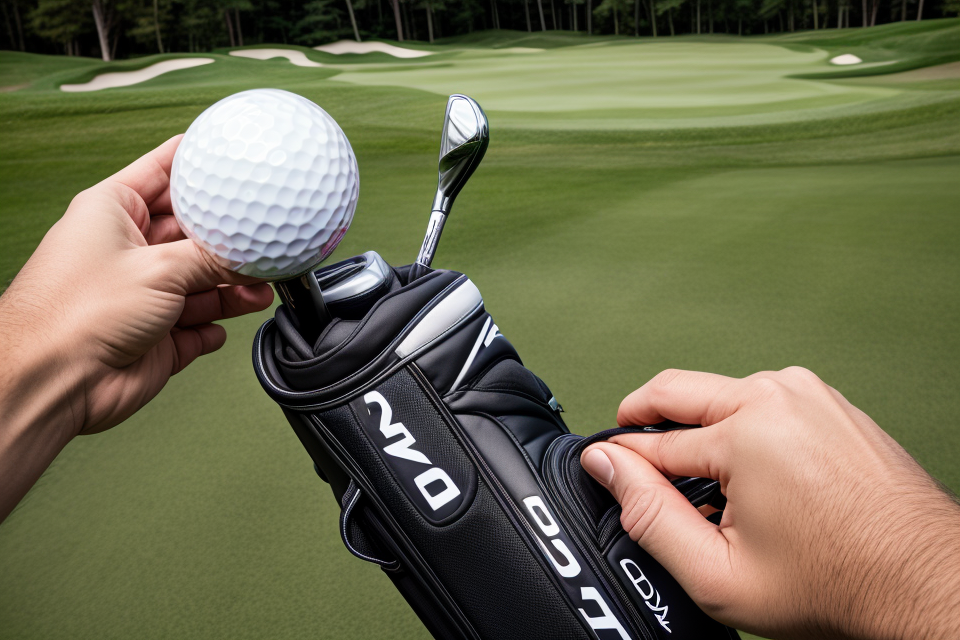
Golf is a sport that requires precision and accuracy, and having the right equipment can make all the difference. Club fitting is the process of customizing golf clubs to a player’s specific needs and swing characteristics. It involves measuring various aspects of a player’s swing, such as the length of their shaft, the lie angle of their clubs, and the distance between their hands and the grip. The goal of club fitting is to optimize a player’s performance by ensuring that their clubs are tailored to their unique swing style. In this article, we will explore the importance of club fitting for golfers of all skill levels and how it can help improve their game.
Understanding Club Fitting
The Process of Club Fitting
Club fitting is a crucial aspect of golf that is often overlooked by many golfers. It involves the measurement and analysis of a player’s swing, as well as the adjustment of the club’s length, grip size, and shaft flex to ensure optimal performance. Here are the details of the process of club fitting:
Measuring and Analyzing Player’s Swing
The first step in the process of club fitting is to measure and analyze the player’s swing. This is done using specialized equipment such as swing analyzers and launch monitors, which provide detailed information about the player’s swing speed, ball speed, spin rate, and other parameters. This data is used to determine the best club specifications for the player, such as the optimal shaft flex, grip size, and club length.
Adjusting Club Length, Grip Size, and Shaft Flex
Once the player’s swing has been analyzed, the next step is to adjust the club’s specifications to match the player’s swing. This may involve adjusting the club length, grip size, and shaft flex. For example, a player with a slow swing speed may benefit from a longer shaft and a heavier grip, while a player with a fast swing speed may benefit from a shorter shaft and a lighter grip. The shaft flex is also adjusted to match the player’s swing speed and tempo.
Testing and Selecting the Best Clubs for the Player
After the club specifications have been adjusted, the player will test the clubs to determine which ones work best for them. This may involve hitting balls on the driving range or playing a round of golf to see how the clubs perform in different situations. The player may also consult with a golf professional to get their opinion on which clubs work best for them.
Overall, the process of club fitting is essential for golfers who want to optimize their performance on the course. By ensuring that their clubs are tailored to their individual swing, golfers can improve their accuracy, distance, and overall performance.
Benefits of Club Fitting
- Improved Accuracy and Distance
- One of the primary benefits of club fitting is the improvement in accuracy and distance. A well-fitted golf club ensures that the ball is struck with precision, resulting in a straighter and longer flight path.
- The fitting process involves adjusting the loft, lie, and length of the club to match the golfer’s swing characteristics. This ensures that the ball is launched at the optimal angle and speed, resulting in improved accuracy and distance.
- Increased Consistency in Swing
- Another advantage of club fitting is increased consistency in the golfer’s swing. A well-fitted club ensures that the golfer is able to replicate their swing without any adjustments, resulting in a more consistent ball flight.
- Consistency is crucial in golf, as it allows golfers to develop a reliable and repeatable swing, leading to better shot-making and lower scores.
- Reduced Risk of Injury
- Poorly fitted golf clubs can lead to an increased risk of injury, as they may cause golfers to adopt an unnatural swing or grip. This can lead to strain on the hands, wrists, and arms, and may even result in a golf-related injury.
- A properly fitted golf club reduces the risk of injury by ensuring that the golfer is able to swing the club with ease and without any awkward movements.
- Better Alignment and Ball Flight
- Proper club fitting also helps golfers achieve better alignment and ball flight. A well-fitted club ensures that the golfer is able to align their body and swing in a way that promotes a straight and powerful ball flight.
- This results in more accurate shots and lower scores, as the golfer is able to control the ball’s trajectory and direction more effectively.
Overall, club fitting is an essential aspect of golf performance, as it helps golfers achieve improved accuracy, distance, consistency, and reduced risk of injury. By ensuring that their clubs are properly fitted to their swing, golfers can optimize their performance on the course and enjoy a more rewarding golfing experience.
The Science Behind Club Fitting
Factors Affecting Club Performance
Player’s Physical Characteristics
A golfer’s physical characteristics, such as height, weight, and swing speed, can significantly impact club performance. For example, a taller golfer may benefit from a longer shaft to achieve proper clubhead speed, while a shorter golfer may require a more flexible shaft to generate power. Additionally, a golfer with a slower swing speed may benefit from a heavier clubhead to increase ball speed and distance.
Swing Style and Mechanics
A golfer’s swing style and mechanics also play a crucial role in club performance. A golfer with a smooth, rhythmic swing may prefer a club with a lower kickpoint, which helps maintain the clubhead’s momentum through impact. On the other hand, a golfer with an inconsistent or unbalanced swing may benefit from a club with a higher kickpoint, which provides more stability and control through impact.
Course Conditions and Terrain
The course conditions and terrain can also affect club performance. For example, a golfer playing on a windy day may benefit from a club with a higher launch angle and lower spin rate to combat the wind’s effects on the ball flight. Similarly, a golfer playing on a course with narrow fairways may prefer a club with a lower spin rate to prevent the ball from spinning too much and losing distance.
In conclusion, there are several factors that can affect club performance, including the player’s physical characteristics, swing style and mechanics, and course conditions and terrain. By considering these factors during club fitting, golfers can optimize their equipment selection and improve their overall performance on the golf course.
Technologies Used in Club Fitting
In modern times, club fitting has become an essential aspect of golf, thanks to the advancements in technology. Various technologies are used to ensure that golfers have the right equipment that fits their game. Below are some of the technologies used in club fitting:
3D Motion Analysis
3D motion analysis is a technology that uses motion capture sensors to track the golfer’s swing and body movements during the shot. This technology is used to identify any flaws in the golfer’s swing and provide feedback on how to correct them. It also helps in determining the right shaft flex and clubhead speed for the golfer.
Launch Monitors
Launch monitors are devices that measure various aspects of the golfer’s shot, such as ball speed, spin rate, and launch angle. This information is used to optimize the golfer’s ball flight and help them achieve their desired results. Launch monitors are also used to fit golfers with the right driver loft and shaft flex.
Ball Flight Tracking Systems
Ball flight tracking systems use high-speed cameras and radar technology to track the ball’s flight trajectory and spin rate. This information is used to optimize the golfer’s ball flight and help them achieve their desired results. Ball flight tracking systems are also used to fit golfers with the right iron loft and shaft flex.
In conclusion, the use of these technologies in club fitting helps golfers optimize their equipment and improve their performance on the golf course. By ensuring that golfers have the right equipment that fits their game, they can reduce their handicap and shoot lower scores.
The Role of Club Fitting in Golf Performance
How Club Fitting Impacts Golf Skills
Ball Striking
Club fitting plays a crucial role in enhancing ball striking skills. It ensures that the golfer uses a club that matches their swing speed, strength, and skill level. When a golfer uses a club that is not suitable for their swing, they may struggle to make consistent contact with the ball, resulting in poor shots and reduced distance. On the other hand, a well-fitted club allows the golfer to make solid contact with the ball, resulting in longer and straighter shots.
Approach Shots
Approach shots require precision and accuracy, and club fitting can help golfers achieve this. A correctly fitted club allows the golfer to control the ball‘s trajectory and distance, ensuring that they can land the ball close to the hole. A poorly fitted club, on the other hand, can result in erratic shots that fail to reach the green or end up in hazards or rough.
Short Game
The short game is all about precision and touch, and club fitting can help golfers achieve this. A well-fitted club allows the golfer to control the ball‘s trajectory and spin, enabling them to execute delicate shots around the green. A poorly fitted club, on the other hand, can result in thinned shots or shots that fail to stop on the green, leading to poor scores.
Putting
Putting is one of the most critical aspects of golf, and club fitting can help golfers improve their putting skills. A correctly fitted putter allows the golfer to control the ball‘s trajectory and speed, ensuring that they can make more putts and sink more birdies. A poorly fitted putter can result in inconsistent strokes and poor rolls, leading to missed putts and lost strokes.
Overall, club fitting is essential for optimal golf performance, as it ensures that golfers use clubs that match their swing speed, strength, and skill level. By using correctly fitted clubs, golfers can improve their ball striking, approach shots, short game, and putting, leading to better scores and more enjoyable rounds of golf.
Factors Affecting Golf Performance
Golf performance is a complex interplay of various factors, including physical abilities, mental game, and course strategy. Let’s delve deeper into each of these factors:
- Physical Abilities: A golfer’s physical abilities, such as strength, flexibility, and endurance, significantly impact their performance. A proper club fitting can help optimize these physical abilities by ensuring that the golfer is using clubs that are tailored to their unique physical attributes. For instance, a golfer with a fast swing speed may benefit from a higher lofted driver to maximize distance, while a golfer with a slower swing speed may require a lower lofted driver to maintain control and accuracy.
- Mental Game: The mental game is a crucial aspect of golf performance, as it affects the golfer’s ability to focus, manage stress, and make crucial decisions on the course. A proper club fitting can help enhance the golfer’s mental game by providing them with clubs that instill confidence and encourage proper swing mechanics. For example, a golfer who consistently slices the ball may benefit from a club with a stronger loft to help keep the ball straighter.
- Course Strategy: The course strategy refers to the golfer’s ability to analyze the course conditions, navigate hazards, and choose the most effective shots for each situation. A proper club fitting can help enhance the golfer’s course strategy by providing them with clubs that suit their playing style and the specific conditions of the course. For example, a golfer who struggles with long par-3s may benefit from a lower lofted approach wedge to help them reach the green, while a golfer who has difficulty hitting high shots over hazards may benefit from a higher lofted fairway wood or hybrid.
In conclusion, golf performance is influenced by a multitude of factors, including physical abilities, mental game, and course strategy. A proper club fitting can help optimize each of these factors, ultimately leading to improved performance and greater enjoyment on the golf course.
FAQs
1. What is club fitting?
Club fitting is the process of selecting and adjusting golf clubs to suit the individual needs and preferences of a golfer. It involves measuring various aspects of the golfer’s game, such as ball speed, spin rate, and launch angle, to determine the optimal club specifications for their swing.
2. Why is club fitting important?
Club fitting is important because it ensures that a golfer is using equipment that is tailored to their swing and playing style. This can lead to improved accuracy, distance, and overall performance on the golf course. Club fitting can also help golfers identify and correct any swing flaws, which can further enhance their game.
3. What happens during a club fitting session?
During a club fitting session, a golfer will typically meet with a club fitter who will assess their swing and golfing needs. The fitter will then recommend clubs and shafts that are suitable for the golfer’s swing, taking into account factors such as ball speed, spin rate, and launch angle. The golfer will then be able to test the clubs and shafts on a launch monitor, which measures various aspects of the golfer’s swing, such as ball speed and spin rate. The fitter will make adjustments as necessary until the golfer is satisfied with the performance of the clubs.
4. How often should I get my clubs fitted?
It is recommended that golfers get their clubs fitted every two to three years, or whenever they experience a significant change in their swing or playing ability. Additionally, if a golfer is experiencing inconsistent performance or struggling with their game, club fitting may be able to help identify and address the issue.
5. Can club fitting improve my golf game?
Yes, club fitting can improve a golfer’s game by providing them with equipment that is tailored to their swing and playing style. This can lead to improved accuracy, distance, and overall performance on the golf course. Additionally, club fitting can help golfers identify and correct any swing flaws, which can further enhance their game.
6. How much does club fitting cost?
The cost of club fitting can vary depending on the location and the extent of the fitting process. Some clubs offer basic fitting services for free, while more comprehensive fitting sessions can cost several hundred dollars. It is important to check with the club fitter to determine the cost of the fitting session and what is included in the price.
7. Can I do club fitting myself?
While some golfers may be able to perform basic club fitting themselves, it is recommended that golfers seek the assistance of a professional club fitter for a more accurate and effective fitting process. A professional club fitter has the knowledge and experience to properly assess a golfer’s swing and make recommendations for equipment that is tailored to their needs. Additionally, a professional club fitter can use specialized equipment, such as a launch monitor, to accurately measure and analyze a golfer’s swing.


